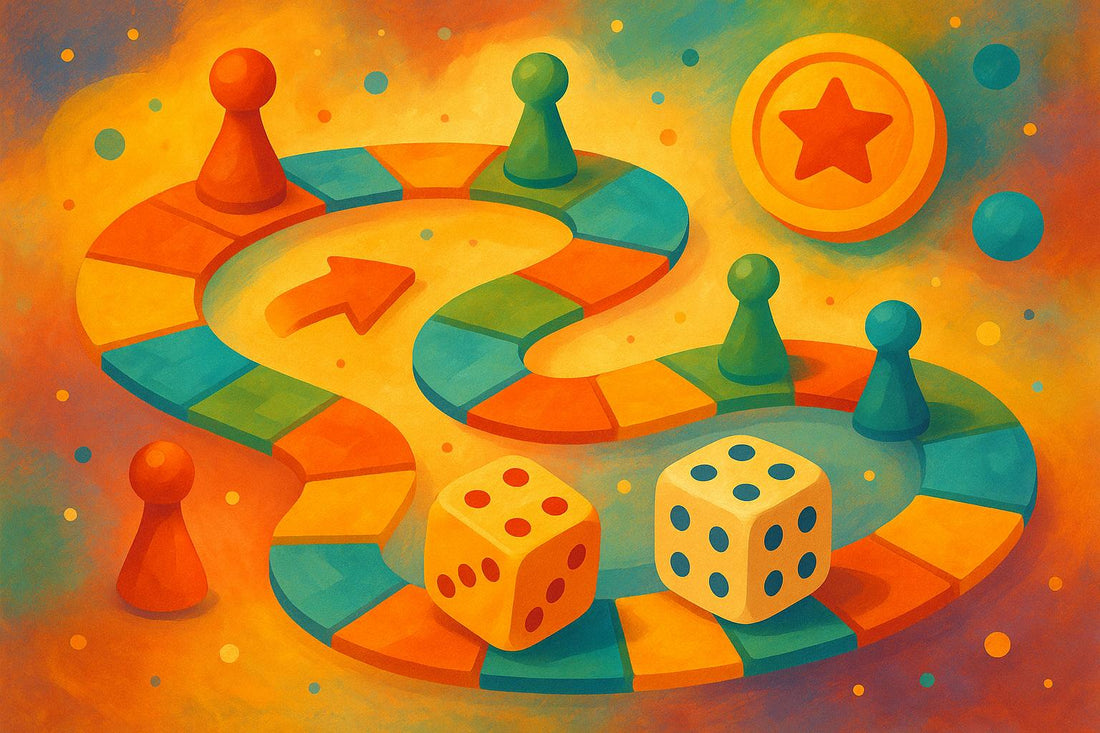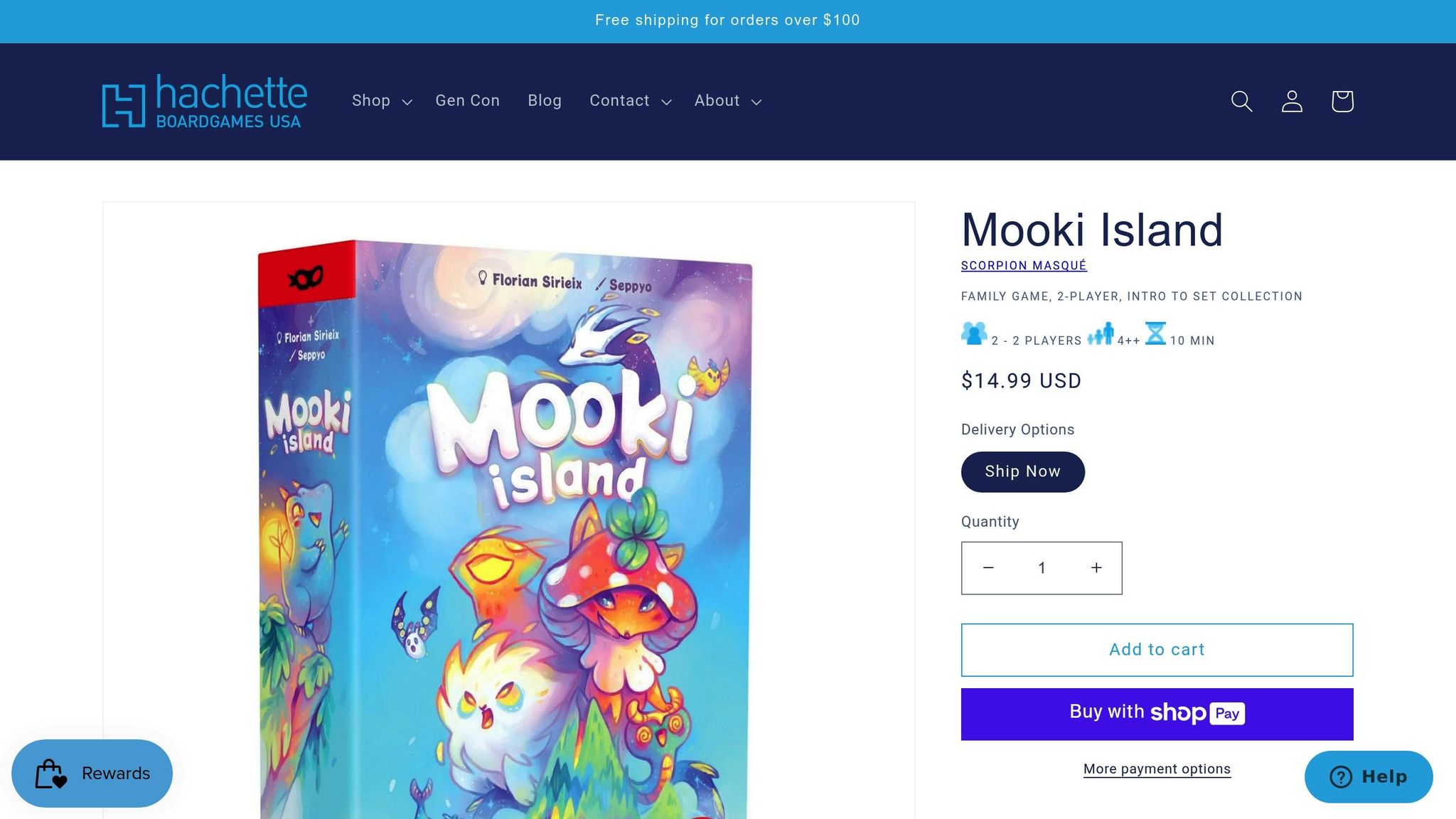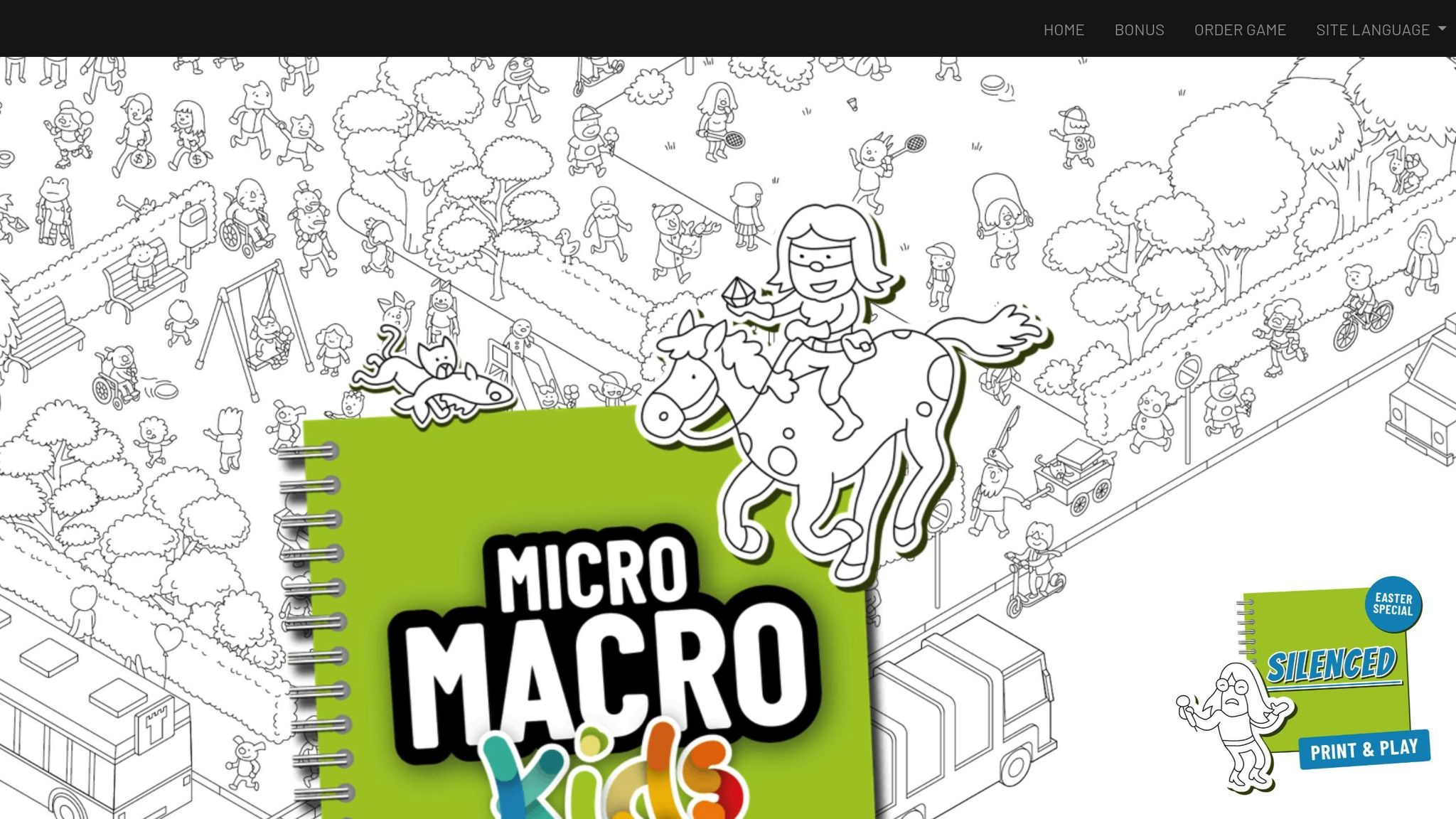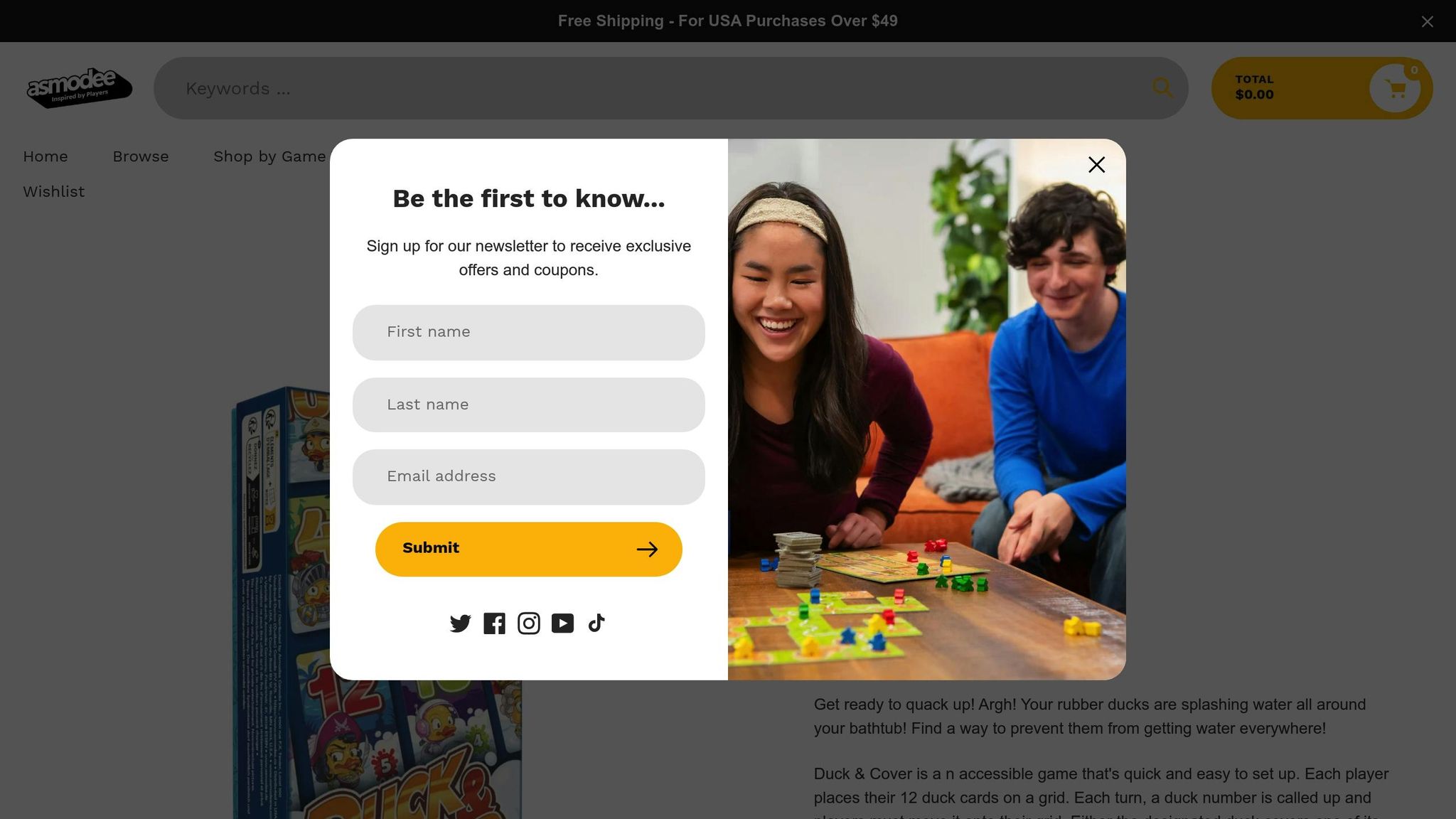Discover the Best Board Games for Every Player

Kids’ Delight: Board Games Little Ones Can’t Resist
Board games are more than just fun - they help kids develop critical thinking, social skills, and patience while creating lasting family memories. From quick games for short attention spans to strategic challenges for older kids, there’s something for every age and interest. Here’s a quick look at five standout games:
- Mooki Island (Ages 4–10): A 10-minute collection game teaching planning and creativity through whimsical characters and storytelling.
- Micro Macro Kids (Ages 6+): A cooperative detective game with 22 mysteries, building observation and teamwork skills.
- Duck and Cover (Ages 8+): A duck-themed twist on BINGO that sharpens decision-making and critical thinking.
- Jungo (Ages 8+): A fast-paced card game for developing memory, patience, and social skills.
- The Sandcastles of Burgundy (Ages 5+): A beach-themed strategy game introducing memory and pattern recognition.
Quick Comparison:
| Game | Age Range | Playtime | Players | Key Skills |
|---|---|---|---|---|
| Mooki Island | 4–10 | 10 minutes | 2 | Planning, storytelling |
| Micro Macro Kids | 6+ | 20–30 mins | 1–4 | Observation, teamwork |
| Duck and Cover | 8+ | 20 minutes | 2–7 | Quick thinking, strategy |
| Jungo | 8+ | 15–25 mins | 2–5 | Memory, patience |
| Sandcastles of Burgundy | 5+ | 20 minutes | 2–4 | Memory, spatial reasoning |
These games combine fun with learning, offering kids a chance to grow while enjoying quality time with family. Ready to pick the perfect game for your child? Let’s dive into the details.
Top Board Games for Children - 2024 Edition!
What Makes Board Games Fun for Kids
The magic of a great children's board game lies in its ability to combine simplicity with engagement. When kids can pick up the rules easily but still find new surprises every time they play, the game becomes exciting and memorable. This balance between straightforward rules and unexpected fun is the foundation of what makes a game enjoyable for kids.
One key element is having rules that match the age and attention span of the players. For example, a 2-year-old typically has an attention span of just 4–6 minutes on average. Games for toddlers need to be quick to set up and deliver instant enjoyment. As children grow, the complexity of the rules can increase to match their developmental stage, keeping them engaged without overwhelming them.
Visual elements are another big draw for kids. Bright colors, playful characters, and interactive components grab their attention even before they fully understand the game. These features are more than just decoration - they help kids connect actions to outcomes and navigate the game world with ease.
Replayability is what keeps kids coming back to a game. The best board games feel fresh every time you open the box, offering new outcomes and encouraging creativity. Games that allow kids to create unique stories or scenarios during play are especially appealing.
What truly sets board games apart is the face-to-face interaction they encourage. As Brian Magerko, a digital-media professor at Georgia Tech, puts it:
"There is something about the co-location of physical items, sitting across from each other at a table, sharing pizza, that playing with digital board games online simply does not replace."
This in-person interaction helps children develop important social skills. They learn to read facial expressions, take turns patiently, and handle both winning and losing gracefully. Studies show that both competitive and cooperative board games can boost behaviors like sharing, helping others, and giving compliments.
Simple gameplay mechanics are another essential ingredient. When the rules are easy to grasp, kids can focus on strategy and social interaction instead of getting stuck on the details. Many great kids' games can be explained in under two minutes but still provide enough depth to grow with the child. Along the way, these games often sneak in learning opportunities, like counting spaces, recognizing colors, or improving hand–eye coordination.
Cooperative gameplay takes this social interaction a step further. Modern kids' games often include elements that encourage teamwork rather than competition. Working together toward a shared goal helps kids build empathy, learn to value teamwork, and appreciate the importance of helping one another. These experiences foster kindness, turn-taking, and collaboration.
The hands-on nature of board games also plays a big role in their appeal. Manipulating game pieces, rolling dice, and moving tokens engages kids' senses in ways that screens simply can't match. This physical interaction helps build neural connections, making the experience more memorable and enriching.
Perhaps one of the most rewarding aspects of board games is how they bring families together. Playing as a family allows parents to understand their kids' thought processes while showing children that adults can have fun - and make mistakes - too. These shared experiences create lasting memories and strengthen family bonds, all without the distractions of screens.
The best children's board games focus on fun and connection, letting kids experiment, learn from mistakes, and enjoy shared play. They strike the perfect balance between entertainment and learning, making every game a joyful experience for everyone involved.
1. Mooki Island

Mooki Island is a delightful introduction to strategic board gaming, specifically designed for young players. This collection game immerses kids in a vibrant, imaginative world where they gather charming Mookies while picking up the basics of majority-based gameplay.
The game strikes a perfect balance between fun and learning. As children collect various Mookies, they naturally begin to develop strategic thinking. The straightforward mechanics encourage them to plan their moves and understand how their decisions impact the outcome. What sets Mooki Island apart is its ability to nurture budding strategists without burdening them with complicated rules.
Adding to the fun, Mooki Island includes a poster that invites kids to dive deeper into the island's whimsical setting. They can name their Mookies and create stories about their adventures, sparking creativity and enhancing language skills. This combination of interactive play and storytelling makes the game a standout.
TheTabletopFamily.com raved about the game, stating, "Our Kids Can't Get Enough". This glowing endorsement highlights how Mooki Island captivates and holds children's attention, making it a favorite for repeat play sessions.
Recommended Age Range
Mooki Island is tailored for kids aged 4 to 10. Its simple gameplay appeals to younger children, while older kids can explore deeper strategies, making it a fantastic option for families with children at varying developmental stages.
Number of Players
The game is designed for 2 players, fostering close interactions. Whether it's a parent and child or siblings playing together, the setup encourages meaningful bonding moments.
Playtime
Each game lasts about 10 minutes, making it ideal for short attention spans. Despite the quick duration, Mooki Island provides a complete gaming experience. Families can enjoy multiple rounds in a single session, experimenting with different strategies along the way.
Key Learning Benefits
Mooki Island goes beyond entertainment, offering valuable learning opportunities. Kids gain an understanding of majority collection games, laying the groundwork for more advanced strategic concepts they'll encounter as they grow. The game teaches them to evaluate choices, count resources, and make decisions with limited information.
It also hones planning and problem-solving skills, as children learn to anticipate their opponent's moves and adapt their strategies on the fly. Meanwhile, the storytelling aspect of the included poster supports language development. Kids expand their vocabulary, practice narrative building, and express their creativity in a relaxed, enjoyable setting.
2. Micro Macro Kids

Micro Macro Kids takes the classic seek-and-find concept and turns it into an exciting detective adventure that’s perfect for engaging young minds. This cooperative puzzle game features 22 cases for children to solve, each one requiring a mix of sharp observation and logical thinking to crack the mystery. Unlike typical hidden object games, Micro Macro Kids weaves storytelling into every case, creating a fresh and immersive experience. It’s more than just a game - it’s a chance for kids to step into the shoes of a detective, working together to uncover clues and solve mysteries.
Players team up to explore a highly detailed city map, tracking suspects, gathering evidence, and piecing together the story behind each case. This cooperative design encourages teamwork and communication, making it a great way to strengthen family bonds while nurturing critical thinking skills.
The game has earned high praise, including 5 mysteries out of 5 from The Family Gamers, who highlighted its outstanding quality and entertainment value. Anitra Smith from The Family Gamers shared her enthusiasm:
"We highly recommend Micro Macro Kids: Crazy City Park, for ANYONE who might like to work through a seek and find mystery, no matter what their age."
This glowing endorsement emphasizes the game’s universal appeal, making it an excellent choice for families looking to enjoy multi-generational gaming sessions.
Recommended Age Range
Designed for kids ages 6 and up, Micro Macro Kids offers family-friendly content that parents can trust. Some cases involve reading, so younger players may need an adult’s help with text. This makes it a great opportunity for shared playtime, where parents can guide their children through the mysteries while boosting their reading skills.
Number of Players
The game supports 1–4 players, making it adaptable for families of all sizes. Whether your child wants to take on the mysteries solo or collaborate with siblings and parents, Micro Macro Kids adjusts to fit the group. The cooperative gameplay encourages players to brainstorm together, share ideas, and work as a team to solve each case. It’s an ideal way to teach kids how to communicate effectively and value teamwork.
Key Learning Benefits
Micro Macro Kids isn’t just fun - it’s also a fantastic learning tool. The game sharpens critical thinking and problem-solving skills as kids analyze the detailed city map to uncover clues. The seek-and-find gameplay enhances visual perception and attention to detail, teaching children to carefully scan complex images, focus on relevant information, and ignore distractions.
The cooperative nature of the game also builds communication and teamwork skills. Players need to discuss their observations, listen to others’ input, and collaborate to solve each mystery. This process helps kids gain confidence in expressing their thoughts while learning to appreciate and integrate the ideas of their teammates. It’s a fun and engaging way to develop skills that will benefit them both in and out of the game.
3. Duck and Cover

Duck and Cover takes the classic BINGO format and gives it a playful, duck-themed twist. This lively game transforms number-calling into an exciting race where players adjust their personal grids of duck cards based on the numbers announced. While it might seem simple at first glance, the game offers enough strategic depth to keep both kids and adults hooked.
Each player starts with a 4x3 grid of duck cards, numbered 1–12, creating a whimsical bathtub scene. As numbers are called, players must quickly decide whether to "duck" or "cover" their cards to dodge imaginary water splashes [30, 31]. What begins as lighthearted fun soon reveals tactical choices that make every round engaging. This mix of easygoing gameplay and subtle strategy ensures the game appeals to a wide range of ages.
As Charlie Theel aptly put it:
"There is actual strategy in how you manipulate your grid... Often, Duck & Cover forces small yet difficult tradeoffs."
Recommended Age Range
This game is designed for ages 8 and up, making it perfect for family game nights. Because it doesn’t rely on reading, even younger children can join in without difficulty. The recommended age aligns well with kids' growing ability to make thoughtful decisions and plan ahead, making it both accessible and rewarding.
Number of Players
Whether you’re playing one-on-one or with a larger group, Duck and Cover works for 2–7 players. It’s flexible enough for intimate parent-child moments or lively family gatherings. The competitive element - trying to avoid the most "splashes" in your bathtub - adds just the right amount of friendly rivalry.
Playtime
With a quick 20-minute playtime, this game fits easily into busy schedules. Its short sessions are ideal for holding kids’ attention while allowing for multiple rounds. This gives players the chance to refine their strategies and enjoy the game again and again.
Key Learning Benefits
Duck and Cover isn’t just fun - it’s a great way to develop important skills. The game promotes quick decision-making and critical thinking as players evaluate their options under time pressure. The simultaneous gameplay also encourages kids to stay sharp while competing with others.
sbb-itb-1ed942f
4. Jungo

Jungo is a lively, fast-paced card game where players compete to be the first to discard all their cards. The straightforward rules keep the action moving quickly, as players juggle their cards and keep an eye on their opponents’ moves.
The game keeps the excitement alive each round, holding everyone’s attention until the very last card is played.
Here’s a closer look at what makes Jungo a great choice for families.
Recommended Age Range
Jungo is suitable for players aged 8 and older, though the game’s strategic elements really shine for those aged 10 and up. This mix of simplicity and depth makes it a fantastic pick for families with kids spanning different age groups.
Number of Players
The game works well for 2–5 players, making it ideal for both smaller groups and larger family game nights.
Key Learning Benefits
Jungo isn’t just fun - it’s also a great way to build important skills. Players develop critical thinking, decision-making, and working memory as they weigh their options and keep track of the game’s progress.
The game also nurtures social skills like patience, turn-taking, and handling wins or losses with grace. On top of that, it encourages a growth mindset by rewarding experimentation and learning from mistakes, making every round a chance to improve and adapt.
5. The Sandcastles of Burgundy

The Sandcastles of Burgundy brings a beach-themed twist to strategic gaming, offering kids an exciting adventure where they help Queen Crab throw the ultimate beach party. The mission? Collect decorations hidden in vibrant sandcastles. This game blends straightforward mechanics with a touch of strategy, making it perfect for young players just starting to explore the world of board games.
The gameplay is simple yet engaging. Players roll colorful dice, search under sandcastles, and match decorations, turning every round into a treasure hunt on the beach. While the mechanics are easy to grasp, they subtly introduce cognitive challenges, helping kids develop essential skills like memory and pattern recognition.
What truly sets this game apart is its flexibility. Designed by Stefan and Susanne Feld, the game grows with your child. It starts with basic rules and gradually adds layers of complexity, allowing parents to adjust the challenge as their child’s abilities evolve.
"The Sandcastles of Burgundy offers children as young as six-years-old the opportunity to experience the world of Castles of Burgundy. In its simplest version, children are first introduced to the basic elements of the game. With additional game elements, the difficulty can be increased – and the game becomes more tactical. There's a lot of interaction between the players." – Susanne Feld
The game borrows the tile-placement mechanics from its adult counterpart but uses colorful dice instead of numbered ones, making it accessible even for pre-readers. This design choice ensures the focus remains on strategy and fun without overwhelming younger players.
Recommended Age Range
The Sandcastles of Burgundy is ideal for kids aged 5 and up, though it’s particularly well-suited for those 6 and older. With a BoardGameGeek complexity rating of 0.00/5, it’s one of the easiest strategy games for children, offering a smooth learning curve that aligns with their natural strengths in memory and pattern recognition.
Playtime
Each game session lasts about 20 minutes, making it short enough to hold young players’ attention while fitting seamlessly into a busy family game night.
Number of Players
The game supports 2–4 players, making it a great choice for small family gatherings or playdates, ensuring everyone gets plenty of turns without long waits.
Key Learning Benefits
The Sandcastles of Burgundy delivers a wealth of learning opportunities disguised as fun. Memory elements challenge kids to remember where decorations are hidden, boosting concentration and recall. The tile-placement mechanics encourage spatial reasoning and planning, while the set collection aspect sharpens pattern recognition. Rolling dice adds an element of unpredictability, teaching kids to think strategically and adapt to changing situations.
"We combined the whole thing with memory elements. Children are particularly good at that." – Stefan Feld
Beyond cognitive skills, the game fosters social and emotional growth. Kids practice turn-taking, learn to handle setbacks gracefully, and celebrate their achievements. The thoughtful design ensures the game remains engaging and educational as children grow, striking a perfect balance between learning and entertainment.
Game Comparison Table
Choosing the right game for your child can feel overwhelming, but this table simplifies the decision-making process. It highlights key details for each game, balancing fun and learning to ensure a rewarding experience for your little one.
| Game | Age Range | Playtime | Players | Learning Benefits | Main Features |
|---|---|---|---|---|---|
| Mooki Island | 4-10 | 10 minutes | 2 | Strategic thinking, planning, storytelling | Collection game with majority mechanics and a creative poster |
| Micro Macro Kids | 6+ | 20-30 minutes | 1-4 | Critical thinking, visual perception, teamwork | Detective mysteries with 22 cooperative cases |
| Duck and Cover | 8+ | 20 minutes | 2-7 | Quick decision-making, critical thinking | BINGO-style duck-themed grid manipulation |
| Jungo | 8+ | 15-25 minutes | 2-5 | Decision-making, working memory, social skills | Fast-paced card shedding game |
| The Sandcastles of Burgundy | 5+ | 20 minutes | 2-4 | Memory, spatial reasoning, pattern recognition | Beach-themed strategy with scalable difficulty |
The playtime listed above reflects typical game sessions, but remember, every child is different. While age recommendations provide a starting point, your child’s unique interests and developmental stage should guide your choice. Board games are not just about entertainment - they help develop critical skills like planning, problem-solving, language abilities, and social behaviors such as cooperation and turn-taking.
If your child has a shorter attention span, consider games with shorter playtimes. Use the table’s details on age, playtime, and player count to find the perfect match for your child’s needs and preferences.
Next, discover how to choose the ideal board game for your child by exploring specific selection criteria.
How to Pick the Right Board Game for Your Child
Finding the perfect board game for your child involves balancing their developmental needs, interests, and attention span. While the age range on the game box is a good starting point, your child’s unique growth and abilities should guide your choice.
Magdalena Oledzka, a Pediatric Physical Therapist at HSS, emphasizes:
"As children go through different developmental stages, the right toy for them should target motor, play and cognitive skills".
When selecting a game, consider your child’s attention span. Most games in our comparison table have playtimes between 10 and 30 minutes, which aligns with the focus levels of many children. Safety is another key factor - always check for small parts that could pose a choking hazard, especially for kids under 3 years old. For example, The Sandcastles of Burgundy uses child-safe pieces, making it a thoughtful choice for younger players.
To keep your child engaged, pick a game that matches their interests. If they love animals, a wildlife-themed game like Jungo might be perfect. For kids who enjoy solving puzzles or mysteries, Micro Macro Kids offers exciting detective adventures.
It’s also worth thinking about developmental goals when choosing a game. For children aged 3–5, look for options that encourage skills like following directions, sharing, and interacting with peers. Lorene Janowski, an Occupational Therapist at HSS, highlights:
"Toys that allow children to use their imagination, role play and think about concepts like number, size and shape go hand in hand with toys that encourage physical activity... These are critical areas of development that children should practice as they continue to grow".
Games that grow with your child are particularly valuable. For instance, The Sandcastles of Burgundy offers adjustable complexity, allowing kids to start simple and gradually tackle more challenging gameplay. You can even modify the rules to suit your child’s current abilities, making the experience more enjoyable and confidence-boosting.
Above all, prioritize fun and connection over competition. Shared laughter and engaging playtime create positive memories and encourage natural learning. Reviews can also be a helpful resource for gauging a game’s age-appropriateness, engagement level, and educational value.
Finally, think about practical factors like the number of players and your family’s social dynamics. Choose games that suit your usual group size and encourage meaningful interaction. Board games provide an excellent opportunity for screen-free bonding, strengthening relationships through shared experiences.
Trust your instincts and knowledge of your child to find a game that delivers fun, learning, and quality family time.
Conclusion
These board games go beyond simple entertainment - they support your child’s growth in meaningful ways. Whether it’s the imaginative building tasks in Mooki Island or the mystery-solving fun of Micro Macro Kids, each game blends enjoyment with opportunities to learn and develop.
Playing these games helps kids practice essential life skills. They encourage patience, turn-taking, sharing, and even learning how to handle losing gracefully. On top of that, they sharpen cognitive abilities like problem-solving and decision-making. As clinical psychologist Beatrice Tauber Prior, Psy.D., points out:
"Strategy games are useful in helping the frontal lobes of the brain develop. Those frontal lobes are responsible for executive function skills, which include planning, organizing, and making good decisions".
Beyond skill-building, these games also strengthen family bonds. They promote teamwork, improve attention spans, and help kids feel more confident in social settings. Whether your child is constructing sandcastles in The Sandcastles of Burgundy or exploring the jungle in Jungo, they’re gaining tools that will serve them for life.
At Brain Games, we’re committed to providing quality play experiences. That’s why we offer our Game Exchange Guarantee, allowing you to swap any game within two weeks if it doesn’t meet your expectations. Plus, our Lifetime Guarantee ensures free replacement of missing or broken pieces as long as the game is still in production. These policies reflect our dedication to supporting your family’s journey, as highlighted by Mark Mehling.
With every game in our collection, you’re opening the door to learning, laughter, and lasting family connections. Start your journey today and give your child experiences that will benefit them for years to come.
FAQs
How do board games help kids build critical thinking and social skills?
Board games are an excellent way for kids to build critical thinking and social skills while having fun. They push children to think strategically, plan their moves, and make decisions, all of which help sharpen their problem-solving abilities. Plus, many games teach kids how to evaluate risks and adjust their strategies as situations change.
Beyond boosting critical thinking, board games play a big role in social development. They encourage teamwork, taking turns, and effective communication. Kids learn to collaborate, navigate the highs and lows of winning or losing, and enjoy genuine, face-to-face interactions. These experiences help them grow in confidence and build strong, positive relationships.
How can I choose a board game that fits my child's age and interests?
When choosing a board game for your child, think about their age, interests, and developmental stage. The game's rules and complexity should match their attention span and abilities. For younger kids, go for simple and interactive games, while older children might prefer something more strategic or imaginative.
Look for games that promote learning, problem-solving, and social interaction to combine fun with a bit of education. Above all, pick something that sparks your child’s excitement - it’s the best way to keep them engaged and enjoying the experience!
How do games like 'Micro Macro Kids' help children build teamwork and communication skills?
Cooperative board games like Micro Macro Kids offer a fun way for children to build teamwork and communication skills. These games push kids to work together, brainstorm ideas, and tackle challenges as a team, creating a strong sense of connection and shared effort.
Through this collaborative play, kids learn to listen actively, stay patient, and articulate their thoughts clearly. Beyond enhancing social skills, these games highlight the importance of achieving goals together rather than focusing on individual wins, turning playtime into a meaningful learning experience.






